Notation: Pitch
Clefs
Clefs are applied to the score from the "Clefs" palette.
Setting the initial clef for a staff
MuseScore automatically applies the most appropriate clef(s) for the instrument when creating a new score. You can easily change this from the score window if needed.
Adding or changing a clef
Add/Change a start clef
To change a clef at the start of a system, use one of the following:
- Select the first measure in the system and click a clef symbol in the palette.
- Drag a clef from the palette onto the first system measure.
- Select the clef and click a clef in the palette.
- Drag a new clef from the palette onto the clef.
Add/Change a mid-measure clef
To add/change a mid-measure clef before a note, use one of the following:
- Click on the note, then click a clef in the palette.
- Drag a clef from a palette onto the note
To add/change a mid-measure clef in front of a barline, use one of the following:
- Select the following measure and click a palette clef.
- Drag a clef from a palette onto the following measure.
Notes: (1) “Mid-staff” clefs are always smaller than the main system clef. (2) Notes after a clef change are automatically repositioned so that they continue to sound at the original pitch.
Delete
To delete a clef, just select it and press Del. Note that clefs at the beginning of systems cannot be deleted.
Controlling the visibility of clefs
Standard clefs
To hide/show clefs at the beginning of all systems except the first:
- From the menu bar, select Format→Style→Page;
- Uncheck/check Create clef for all systems.
Mid-measure clefs are unaffected.
To hide/show all clefs on a selected staff:
- Right-click on a measure;
- Choose "Staff/Part properties";
- In the dialog, uncheck "Show clef".
This affects clefs at the start of a system and mid-measure.
Courtesy clefs
To hide/show courtesy clefs:
- From the menu bar, select Format→Style→Page;
- Uncheck/Check the Create courtesy clefs.
If courtesy clefs are enabled, you can still hide an individual courtesy clef as follows:
- Select the relevant standard clef;
- In the Properties panel, uncheck/check Show courtesy clef on previous system.
Clefs and transposition
Using octave clefs
[To be added]
Using different clefs for transposed and concert pitch
[To be added]
Clef properties
See Courtesy clefs (above).
Clefs applied to an entire measure or the first note in a measure are shown before the barline.
To move the clef after the barline:
1. Select the clef
2. Open the Properties panel
3. Under Position relative to barline, choose After
To replace the first clef in a score, see Add/Change a start clef.
Clef style
Tablature users can select the type of TAB clef displayed:
- From the menu, select Format→Style→Clefs
- Set the default TAB clef to "Standard" or "Serif" as required.
Other style properties are available in Format→Style→Page, namely:
Create clef for all systems
Create courtesy clefs
For details, see Controlling the visibility of clefs (above).
Key signatures
Overview
Key signatures are applied to the score from the "Key signatures" palette.
Setting the initial key signature for your score
The initial key signature is set from page 2 of the New Score dialog.
Adding a key signature change to your score
Use one of the following methods:
- Select a measure and click a key signature in the palette.
- Drag a key signature from the palette onto an empty part of a measure.
Note: It is also possible, though uncommon, to add a key-signature mid measure by selecting a note then clicking a palette key signature, or dragging the key signature to a note.
Adding a local key signature for a single staff
If you wish to add a key signature to only one staff, leaving others unchanged, apply one of the following methods:
- Select the measure from which you want the new key signature to apply, then press and hold Ctrl (Mac: Cmd) and click on a key signature in the (Key signatures) palette.
- Press and hold Ctrl (Mac: Cmd), then drag a key signature from a palette on to a measure.
Selecting a key signature for a single staff
If you wish to select a key signature for a single staff only, press and hold Ctrl (Mac: Cmd), then click on the key signature.
Replacing an existing key signature
Use any of the following methods:
- Select the key signature to be replaced, and click a new key signature in a palette.
- Drag a key signature from the palette onto the key signature to be replaced (or onto the measure containing the key signature).
To replace the key signature on a single staff only, press and hold Ctrl (Mac: Cmd) before carrying out the above operations.
Deleting a key signature
- To delete a key signature in the score, select it and press Del.
- To delete a key signature from single staff only, hold Ctrl (Mac: Cmd) while selecting it, then press Del.
Controlling the visibility of key signatures
To show key signatures only at the beginning of a score, and at a key change:
- From the menu bar, select Format→Style→Page;
- Uncheck/Check "Create key signature for all systems".
To hide/show all courtesy key signatures (at the end of systems):
- From the menu bar, elect Format→Style→Page;
- Uncheck/Check "Create courtesy key signatures".
To hide/show a particular courtesy key signature:
- Select the parent key signature;
- In the Properties panel, uncheck/check "Show courtesy key signature on previous system".
Key signatures and transposing instruments
Care needs to be taken when working in written pitch and applying a key signature directly to a transposing instrument. For example, a Bb clarinet is written a tone higher than it sounds; so, to get the clarinet to display in G major, you need to apply a key signature of F major from the palette. And so on.

Open/Atonal key signature
Some instruments (e.g. French horn) are conventionally written with no key signature. To achieve this, you need to add an open/atonal local key signature to the staff (this is already done in scores created from templates).
An open/atonal key signature looks similar to a 'C major/A minor' key signature. However, unlike standard key signatures, an open key signature always remains the same, regardless of key changes to the rest of the score.
Creating a custom key signature
To create a custom signature:
- In the "Key signatures" palette, click More, then Create key signature
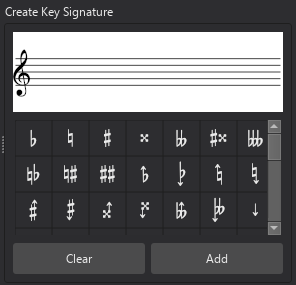
-
Drag accidentals onto the staff image as required. Note: Accidentals are horizontally aligned by default. If you want to place an accidental in a custom position, hold Ctrl (Mac: Cmd) while dragging it.
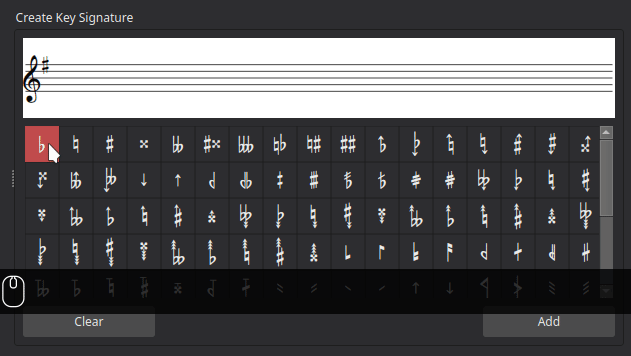
-
To remove an accidental select it and press Del. Note: The Clear button deletes all added accidentals.
- To add the completed signature to the main palette, click Add.
Note: Custom key signatures are adapted to transposing instruments automatically. If You want transposing instrument to use custom key signature exactly the same, as it is in palette, You need to transpose it back. Select measure where key signature is placed and use Tools→Transpose.
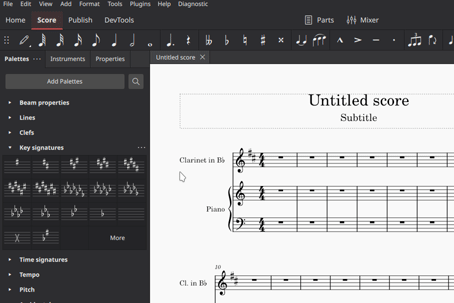
Key signature properties
You can edit properties specific to key signatures in the Key signature section of the Properties panel:
Show courtesy key signature on previous system: See Controlling the visibility of key signatures (above).
Mode: You can select a mode for the key signature if required—major, minor, dorian etc. The default is "unknown".
Key signature style
Various style properties affect key signature display.
Format→Style→Page
Create key signature for all systems
Create courtesy signatures
The use of these properties is discussed in Controlling the visibility of key signatures (above).
Format→Style→Accidentals

Here you can change the way accidentals are displayed in key signature changes in the score.
Format→Style→Measure
Clef to key signature
Key signature to time signature
Barline to key signature
Key signature to barline
Key signature to first note
These properties control the various distances before and after key signatures in the score.
See also
Transposition
Overview
Transposition is the act of raising or lowering the pitch of a selection of notes by the same interval.
In MuseScore, you can transpose your music using keyboard shortcuts, or via the Transpose dialog.
Transposing with keyboard shortcuts
To transpose with keyboard shortcuts, first select a range of notes (See Selecting elements). Then use one of the following options, depending on how you need to transpose your music:
Transpose chromatically
Press ↑ or ↓ to move the selection up/down in semitone steps
Transpose diatonically
Press Alt+Shift+↑/↓ to move the selection up/down in scale degrees (Mac: ⌥+Shift+↑/↓).
Transpose by an octave
Press Ctrl+↑/↓ to move the selection up/down in octave steps (Mac: ⌘+↑/↓).
Using the transpose dialog
The Transpose dialog gives you more control over transposition, with options to transpose to selected keys or by specific intervals.
First select a range of notes you wish to transpose. (See Selecting elements). If no selection is made, the whole score is automatically selected for transposition.
Then open the dialog by selecting Tools → Transpose...
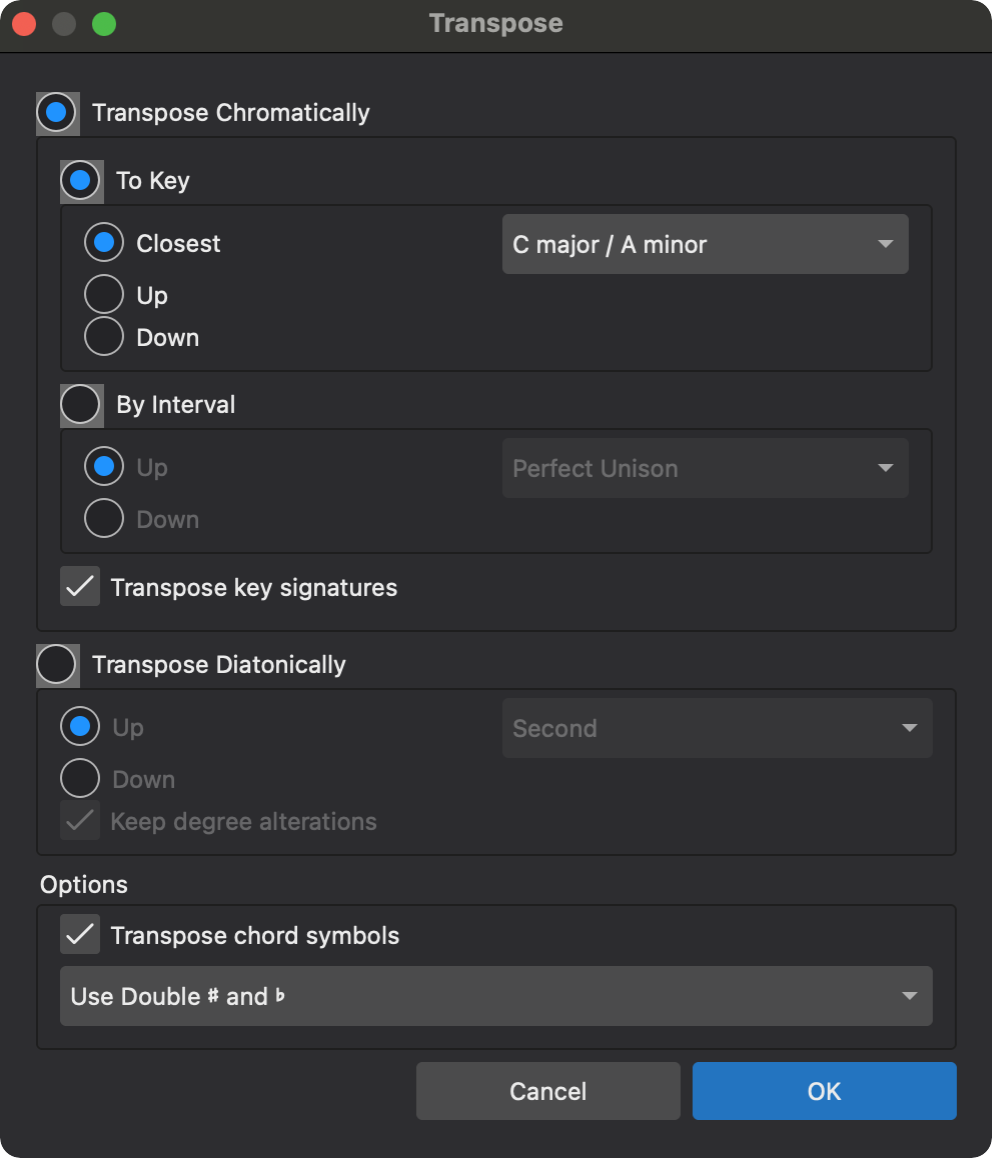
Transpose Chromatically
When this is selected, you can choose to transpose to a specific key, or by specified interval.
To transpose chromatically to a specific key:
- Select To key
- Select whether to transpose to the Closest key (relative to the current key signature of the selection), or Up or Down to the destination key signature
- Choose your destination key signature from the drop down menu
- Leave Transpose key signatures selected to transpose any existing key signatures in your selection (deselecting this will leave any existing key signatures unchanged)
- Leave Transpose chord symbols selected to transpose any existing chord symbols in your selection (deselecting this will leave any existing chord symbols unchanged)
- Click OK
To transpose chromatically by interval
To transpose selected notes up or down in semitone increments:
- Select By interval
- Select whether to transpose your selection Up or Down by the specified interval
- Select the transposition interval from the drop down menu
- Select options for Transpose key signatures and Transpose chord symbols as required (see above)
- Click OK
Transpose Diatonically
Select this to transpose the selection by a specified interval without changing the existing key signature(s). Note: the intervallic relationships between pitches in your selection will change as a result!
- Select Transpose Diatonically
- Select whether to transpose your selection Up or Down by the specified interval
- Leave Keep degree alterations selected to retain any accidentals in the selection (Note: accidentals will be modified relative to the existing key signature. Note also: Deselecting this will remove any existing accidentals upon transposition)
- Leave Transpose chord symbols selected to transpose any existing chord symbols in your selection (see above)
- Click OK
Working with transposing instruments
Transposed and concert pitch
Transposing instruments (such as the clarinet, French horn, trumpet etc.) are notated at a different pitch (and key signature) to how they sound. The notated pitch is called the written pitch, while the actual pitch is called concert or sounding pitch.
By default the program is displayed with all the staves at written pitch. However, if you wish to view the score at concert pitch just check the "Concert pitch" box (to the left of the tuning fork icon) in the status bar.

Setting the interval of transposition
When you set up a score in the New Score, or Add or remove instruments dialogs, transposed key signatures are automatically applied to any transposing instruments. However if for any reason you need to set up the staff transposition manually, this is how to do it.
- Right-click on the instrument staff and select Staff/Part properties;
- Next to "Transpose" in the lower part of the dialog, select the interval that the instrument sounds above/below concert pitch. (Music for the Bb clarinet, for example, is written a tone above its sounding pitch and the transpose setting is therefore a major second down.)

- Click OK.
The correct transposed key signature will now appear on the staff.
Controlling enharmonic spelling
The enharmonic spelling of the transposed key signature, whether in sharps or flats, is set in Staff/Part properties (see Setting the interval of transposition ).
To change the enharmonic spelling of pitches in the score, see Change spelling.
Octave lines
Overview
Octave (Ottava) lines are used to indicate that a section of music is to be played one or more octaves above or below written pitch; the line may be dotted or solid:
8--------┐or 8va--------┐: Play one octave above written pitch.
8--------┘or 8va--------┘: Play one octave below written pitch.
8va alta/bassa lines are particularly common in piano scores, though they are sometimes used in other instrumental music. 15ma alta (2 octaves above) and 15ma bassa (2 octaves below) are also occasionally used.
MuseScore automatically adjusts playback of the score under the ottava to the correct pitch.
Ottava lines may be found in the Lines palette.
Adding an octave line to your score
See Adding a line to your score.
To adjust the range and vertical position of the line, see Adjusting elements directly.
Octave line properties
Properties specific to the selected ottava(s) can be adjusted in the Ottava section of the Properties panel, namely:
Style tab
Type: Specifies whether the Ottava line is 8va, 8vb etc.
Show number only: Hides any text (such as “va”).
Show line: Makes the line visible / invisible. Text is unaffected.
Allow diagonal: Allow line to slope if required.
For other properties in this tab, see Line properties.
Text tab
This has a similar user interface to general lines (see Line properties), but uses special code to specify the ottava text.
Octave line style
Default properties for ottavas can be adjusted in Format→Style→Ottava.
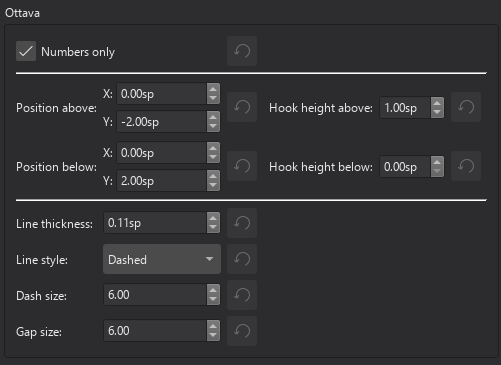
Noteheads
Overview
This chapter discusses the appearance of noteheads in MuseScore.
Notehead schemes
One aspect of music notation systems is notehead scheme. A scheme is a set of rules used to decide notehead shape's meaning, some of which are supported in MuseScore. Supported schemes relate notehead meaning to a note's:
- duration: as in the most widely used scheme.
- pitch (using movable-do or absolute pitch solfege): literally written on it, and
- pitch (relative pitch using shape note solfege): as in "shape note notation" (see reference under External links).
The most widely used scheme is very likely the only one known to most musicians. It is referred to as "Normal" in MuseScore and is the default setting for a new staff. Details of the nine schemes available in MuseScore are covered in Custom staff types:Notehead scheme.
Understanding relative pitch notations (shape note solfege, shape note notation) can enhance the reader's comprehension of this chapter. Most of the time, a notehead shape conveys one specific meaning, and that meaning is only associated with one notehead shape. Shape note solfege is like a variant of movable-do solfege that belongs to the exceptions. For example, in one type of "shape note notation", a triangle must be used to notate a relatively pitched "C4", but triangles are also read as relatively pitched "C"s or "F"s only, and triangles must sing "Fa" or a syllable agree upon by singers on-site. The loosely related shape note solfege notates interval perception much better than the "Normal" setting.
Notehead shape
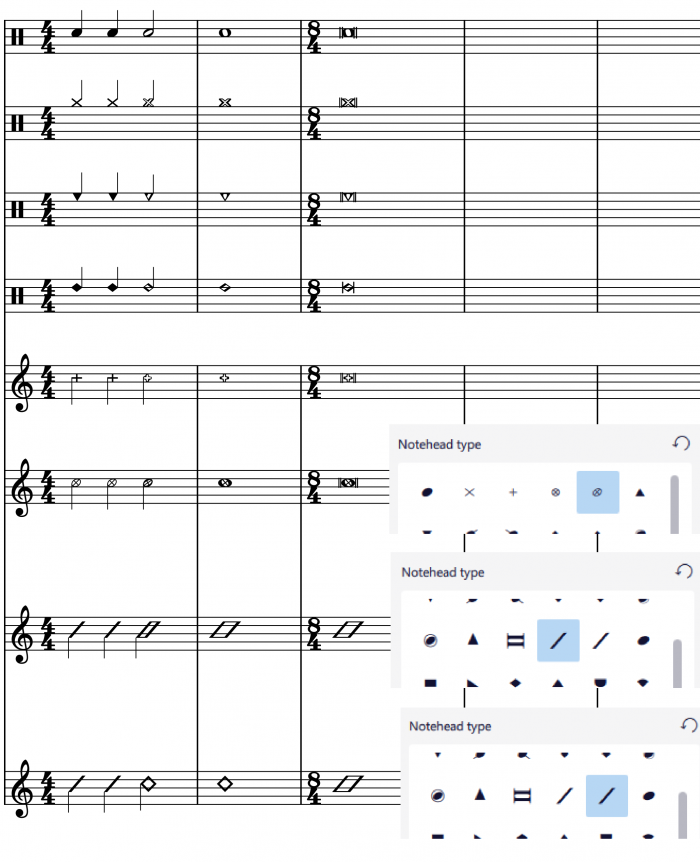
Shown above, the diamond notehead can be used for harmonic notes in guitar, violin etc; and slash notehead for guitar strums etc. The cross is also known as crosshead, ghost note, or dead note.
Final display of notehead shape in MuseScore is determined by three factors: the notehead type factor, the pitch factor, and the duration factor (or note-value, rhythm).
Pitch factor
Note pitch may affect affect notehead shape, depending on the scheme, but it only happens on note(s) that do not use an overriding Notehead type property. See "Notehead type factor" section. "Normal" notehead scheme does not use pitch to determine notehead shape.
Duration factor
The duration factor is determined by a note's duration. To edit duration see Entering notes and rests and Editing notes and rests chapters. It also can be visually overridden for an individual note, while keeping the real value and playback intact.
Notehead type factor
Options available for notehead type factor depends on staff type:
- On Standard staffs (type 1a, type 1b), there are three levels:
- Level 1 Notehead scheme of a staff : Default is "Normal".
- Level 2 Notehead scheme of a note (option named "Notehead System" in Musescore 4.1.1):
- The default option "Auto" means "ignore this level".
- Other options: scheme to use on this note, overrides Level 1.
- Level 3 Notehead type property of a note. Affects notehead shape if and only if the result scheme of Level 1 and Level 2 is "Normal".
- Tablatures (type 2) do not use notes. To change selected fret number(s) into crosshead, click the cross item in the Noteheads palettes. To enclose selected fret number(s) with brackets (parentheses, dead note or ghost note), use Shift+X. Only the first two items of Noteheads palettes works on Tablatures.
- On percussion staffs (type 3), instrument (like snare or hi-hat, not the "drumset" MuseScore Instrument) determines the notehead type factor. See Entering and editing percussion notation: Notehead shape chapter.
Notehead scheme is used to determine notehead shape unless overridden by individual note's Notehead type property. When notehead scheme is not overridden, note pitch may affect notehead shape, depending on the scheme. "Normal" notehead scheme does not use pitch to determine notehead shape. When a note uses an overriding Notehead type property, note pitch information does not affect notehead shape at all.
Changing notehead shape
Notehead type factor
- (Valid on standard staffs only) To change level 1 notehead scheme of a single staff, affecting all notes:
- Right click on an empty part of the desired staff and select Staff/Part properties.
- Click on the Advanced style properties button (opens Edit Staff Type window).
- Select an option in Notehead scheme dropdown.
- (Valid on standard staffs only) To change level 2 notehead scheme of note(s):
- Select note(s) on a score.
- In the Properties panel, open Note: Head tab.
- select an option from the Notehead system dropdown (you may need to click "Show more" at the bottom of the panel to reveal it): the default "Auto" means "ignore this level".
- (Valid on standard staffs only) To change level 3 notehead type property:
- Select note(s) on a score.
- Use one of the following:
- In Properties panel, open Note: Head tab, select a Notehead type, or
- Click on an item in the Noteheads palettes, or drag it onto a notehead in the score.
- To change selected fret number(s) into crosshead, click the cross item in the Noteheads palettes. To enclose selected fret number(s) with brackets (parentheses, dead note or ghost note), use Shift+X.
- To change noteheads on percussion staffs, see Entering and editing percussion notation: Notehead shape chapter.
Duration factor
- To change note duration, see Entering notes and rests and Editing notes and rests.
- To change the apparent duration without altering real value so that playback is not affected:
- Select note(s) on a score.
- In the Properties panel, open Note: Head tab.
- Select the desired option from the Override visual duration (you may need to click "Show more" at the bottom of the panel to reveal it): the default "Auto" means "no override"
Adding pitch information to notes

shown above 7 Shape (Aikin), a "shape note notation"
There are six methods to change "pitch".
Most of the time, a note's pitch only affects its staff space / vertical position, to change it:
- Change note pitch, see Entering notes and rests and Editing notes and rests.
- Modify the playback pitch of note(s) on score without altering notation: In Properties panel, click General: Playback , edit Tuning (cents). This is useful for reasons explained in Musescore 3 Handbook's Tuning systems, microtonal notation system, and playback. Does not work on instruments using Muse sounds (yet) on Musescore 4.1.1
Tablatures, percussion staffs and some notehead scheme (see Overview) use notehead shape to convey pitch information:
- [not working yet, upcoming fixed 4.3 https://github.com/musescore/MuseScore/issues/16500 ] The brackets (parentheses, dead note or ghost note) item in Noteheads palettes can be added to a note or accidental.
- To change selected fret number(s) into crosshead, click the cross item in the Noteheads palettes. To enclose selected fret number(s) with brackets (parentheses, dead note or ghost note), use Shift+X.
- To use custom notehead shape for visual pitch representation:
- Change level 1 setting as required for the staff.
- Use a level 2 overriding setting on selected note(s):
- Select note(s) on a score.
- In the Properties panel, open Note: Head tab.
- Select an "Normal" from the Notehead system dropdown (you may need to click "Show more" at the bottom of the panel to reveal it).
- Assign level 3 notehead type property. Use either one of the following:
- In Properties panel, open Note: Head tab, select a Notehead type, or
- Click on an item in the Noteheads palettes, or drag it onto a notehead in the score.
- These note(s) will be always use this item, regardless of any future pitch change by user unlike other notes on this staff.
- Change duration factor as required.
- To loosen the relationship between note vertical position and pitch so that all notes on a staff create desired playback, take advantage of 'Transposing instruments' feature.
Changing notehead direction
To move notehead(s) horizontally to the other side of stem, use one of the following:
- Press Shift+X, or
- In Properties panel, open Note: Head tab, select a Notehead direction (you may need to click "Show more" at the bottom of the panel to reveal it).

(Note: Contrast this command with X which moves the stem and beam horizontally and vertically to other side of the notehead)
Notehead properties
Selecting a note(s) on score, in the Properties panel Note: Head tab :
- Notehead parentheses: Add or remove parentheses.
- Notehead type: See overview and changing notehead shape.
- Hide notehead: Makes notehead invisible, see Properties: visibility.
- Small notehead
- Duration dot position: This provides an alternative vertical offset for the duration dot.
- Show more / Show less button
- Notehead system: level 2 Notehead scheme, see Overview. The default "Auto" means "ignore this level".
- Override visual duration: change duration factor, see Overview. "Auto" means "no override".
- Note direction: See Changing notehead direction (above).
- Notehead offset: This changes the offset of the notehead only (to change the offset of the complete note, use "Offset" in Properties: Appearance instead).
Notehead style and font
There are 8 font options (two new options compared to MuseScore 3) for notehead set in Format→Style→Score. Notehead does not use style profiles (Templates and styles).
Noteheads palette is displayed with Bravura font.
Sharing noteheads between voices
When two notes in different voices coincide on the same beat, they can either share a single notehead, or else be offset to allow the display of both noteheads. This is done automatically by MuseScore according to certain rules (see below).
To force two offset noteheads in different voices to share a single notehead, use one of the following methods:
- Make the smaller-value notehead invisible. This works for the majority of cases.
- Select the smaller value notehead and in the Note section of the Properties toolbar change "Head type (visual only)" to that of the higher value note.
Rules for automatically sharing or offsetting noteheads:
- Notes with stems in the same direction do not share noteheads.
- Dotted notes do not share noteheads with undotted notes.
- Black notes do not share noteheads with white notes.
- Whole notes never share noteheads.
Remove duplicate fretmarks in tablature
If you are using paired standard and tablature staves you will come across situations where a shared notehead in the standard staff generates two fretmarks in tablature. In this case simply hide one of the fretmarks by making it invisible.
See also
External links
Ambitus
An ambitus indicates the range of notes included within a stave. It is used to indicate the appropriate voice for a particular part. See Wikipedia: Ambitus.
Adding an ambitus to your score
To create an ambitus choose one of the following methods:
- Select the desired start clef and click on the ambitus symbol in either the Pitch or Lines palette.
- Drag the ambitus symbol from either the Pitch or Lines palette and drop it onto the desired start clef.
Changing the range of an ambitus
The top and bottom notes of the range can be manually adjusted via Properties.
Ambitus properties
Four different properties of the ambitus can be manually altered:
1. style: vertical or diagonal
2. notehead type
3. notehead duration
4. line thickness of the line joining the two noteheads
Respell pitches
Manually changing the enharmonic spelling of notes
To change the enharmonic spelling of a note, or notes, in both written and concert pitch views:
- Select a note, or group of notes;
- Press J;
- Continue pressing J to cycle through the enharmonic equivalents.
To change the enharmonic spelling in the written pitch view, without affecting the concert pitch view, or vice versa:
- Select a note, or group of notes;
- Press Ctrl+J (Mac: Cmd+J);
- Continue pressing the same combination of keys to cycle through the enharmonic equivalents.
Note: If the pitches of selected notes are not all the same, the effect may be unpredictable.
Automatically respelling all notes in a selection
Respell pitches
- From the menu, select Tools→Respell Pitches.